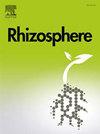Microbiome analysis of the lithophytic resurrection plant Ramonda heldreichii, reveals root driven tight-rhizosphere vs elevation specific loose-rhizosphere communities
IF 3.4
3区 生物学
Q1 PLANT SCIENCES
引用次数: 0
Abstract
We investigated the root microbiome of a relict resurrection (desiccation/frost-tolerant/resistant) plant, endemic to Mount Olympus (Litochoro, Greece), Ramonda heldreichii (Boiss.) C.B.Clarke, at various altitudes (400 m–1200 m asl), through amplicon sequencing. Microbial communities (prokaryotes, fungi, protists) revealed the significant impact of roots on the tight rhizosphere (TR) that were less diverse and less altitude-impacted compared with the loose rhizosphere (LR). Prokaryotic α-diversity was highly affected by root, whereas that of fungi was comparatively more sensitive to altitude. The TR-associated taxonomic groups, included well equipped taxa for tolerating biotic and abiotic stresses (drought/metal tolerance, microcystin degradation, psychrotolerance, chitin degradation) with Cercozoa dominating protists, while the LR-associated taxa mainly included microorganisms with chemolithoautotrophic potential. Relative abundances of the N-cycling and greenhouse gas associated Nitrosopheraceae, were increased with altitude. Collectively, the study of R. heldreichii demonstrated a plant-driven TR with bioprospecting potential, and an elevation-shaped and climate-linked LR, providing novel insights about mountain microbiology.
对石生复活植物拉蒙达(Ramonda heldreichii)的微生物组分析表明,根系驱动的紧密根圈群落与海拔高度特定的松散根圈群落存在差异
我们通过扩增子测序研究了奥林帕斯山(希腊利托乔罗)特有的孑遗复活植物(耐干燥/耐霜冻/抗冻)Ramonda heldreichii (Boiss.) C.B.Clarke在不同海拔高度(400米-1200米)下的根系微生物群落。微生物群落(原核生物、真菌、原生生物)显示,根系对紧密根圈(TR)的影响很大,与松散根圈(LR)相比,紧密根圈(TR)的多样性较少,受海拔高度的影响也较小。原核生物α的多样性受根系的影响很大,而真菌的多样性对海拔高度相对更敏感。与 TR 相关的分类群包括耐受生物和非生物胁迫(耐旱/耐金属、降解微囊藻毒素、精神耐受性、降解几丁质)的装备精良的分类群,原生动物以纤毛虫为主,而与 LR 相关的分类群主要包括具有化石自养潜力的微生物。随着海拔的升高,与氮循环和温室气体相关的硝化菌科(Nitrosopheraceae)的相对丰度也在增加。总之,对R. heldreichii的研究表明,植物驱动的TR具有生物勘探潜力,而海拔高度与气候相关的LR则为山区微生物学提供了新的见解。
本文章由计算机程序翻译,如有差异,请以英文原文为准。
求助全文
约1分钟内获得全文
求助全文
来源期刊

Rhizosphere
Agricultural and Biological Sciences-Agronomy and Crop Science
CiteScore
5.70
自引率
8.10%
发文量
155
审稿时长
29 days
期刊介绍:
Rhizosphere aims to advance the frontier of our understanding of plant-soil interactions. Rhizosphere is a multidisciplinary journal that publishes research on the interactions between plant roots, soil organisms, nutrients, and water. Except carbon fixation by photosynthesis, plants obtain all other elements primarily from soil through roots.
We are beginning to understand how communications at the rhizosphere, with soil organisms and other plant species, affect root exudates and nutrient uptake. This rapidly evolving subject utilizes molecular biology and genomic tools, food web or community structure manipulations, high performance liquid chromatography, isotopic analysis, diverse spectroscopic analytics, tomography and other microscopy, complex statistical and modeling tools.
 求助内容:
求助内容: 应助结果提醒方式:
应助结果提醒方式:


